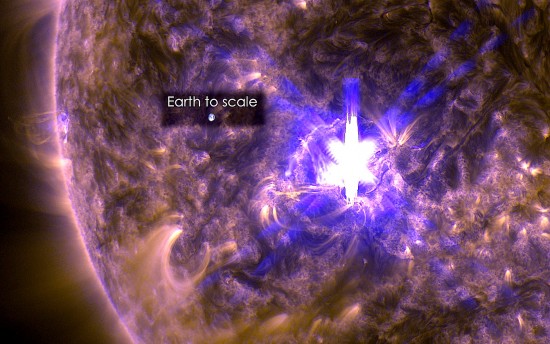
An X2.2 solar flare on March 11, 2015 from NASA’s Solar Dynamics Observatory (SDO). This image is a blend of two images: one recorded in the 171 angstrom wavelength, the other in 131 angstroms. Credit: NASA/SDO/AIA
Sep 4, 2015
It is an electronic Sun.
Various components coupled to and driven by electric circuits in space comprise the heart of Electric Universe theory. Charged particles accelerating through powerful electric fields radiate energy in many bandwidths.
Glowing, braided filaments are sometimes visible in “jets” that blast out from stars and some galaxies. Those filaments are called Birkeland currents, and they are the visible portion of enormous electric circuits that form a large-scale structure in the Universe. The circuits generate magnetic fields that can be mapped, so the helical shape characteristic of Birkeland currents is known, since it can be seen.
Plasma’s behavior is driven by conditions in those circuits. Fluctuations in current flow form double layers with enormous voltages between them. This means that electric forces in double layers can be several orders of magnitude stronger than gravity. Double layers separate plasma into cells that can have different temperatures or densities.
As part of galactic interactions, the Electronic Sun theory postulates that sunspots, solar flares, anomalous coronal heating, and coronal mass ejections on the Sun are also due to changes in the electrical supply that it receives from the galaxy. In other words, the Sun is powered externally not internally, and it is not a self-regulating fusion reactor. Rather, Birkeland current filaments carry electricity through the Milky Way, supplying the Sun with more or less power as they go.
In an Electric Universe, plasma discharge behavior is thought to be the best model for solar activity. Laboratory experiments with a positively charged sphere show that a plasma torus forms above its equator. Electric discharges bridge the torus with the middle and lower latitudes of the sphere. Spicules are consistent with the principle of “anode tufting,” a plasma discharge effect expected of a positively charged electronic Sun.
Closeup images of sunspot filaments, seen clearly in sunspot penumbrae, indicate that they are charge vortices. Looking down into a sunspot means seeing the rotating discharge columns in profile. Electric discharges in plasma form rope-like, hollow tendrils. Since they are funnels of plasma, their centers are darker, where convection cells would appear darker at their edges.
The massive filament observed in association with the March 11, 2015 solar eruption spawned an X2.2 solar flare, revealing its electrical association. Although it was an Earth-facing event, it did not affect Earth-based or space-based communication systems. The Sun has not been so violent for several months since that date and appears to be entering a more quiescent phase.
Conventional thinking suggests that the Sun accelerates charged particles (solar flares and prominence eruptions) into space in the same way that sound waves are amplified. The photospheric plasma is said to travel outward through “acoustical wave-guides,” known as magnetic flux tubes. Structures called spicules rise thousands of kilometers above the photosphere and carry the hot gas with them.
However, if the Sun is the locus of positive charge with respect to interstellar plasma, sunspots will appear when electric discharges penetrate the photosphere, allowing electric current to flow into its depths. Electromagnetic flux tubes expose the Sun’s cooler interior. The idea of acoustic heat transfer from the core cannot be supported by any observations of the Sun.
This underscores Electric Universe advocate Wal Thornhill’s assertions: “While enormous time and resources have been poured into the effort to understand stars based on a single outdated idea, those familiar with plasma discharge phenomena have been paying close attention to the observed phenomena on the Sun and finding simple electrical explanations…It is an engineer’s view that offers a coherent understanding of our real place in the universe (cosmology) and practical insights for the future exploration of space. If the Sun shines as an electric light ‘plugged in’ to the Electric Universe, the objective tests become obvious. Perhaps, with a real understanding of stars we may reach childhood’s end in the cosmos.”
Stephen Smith












